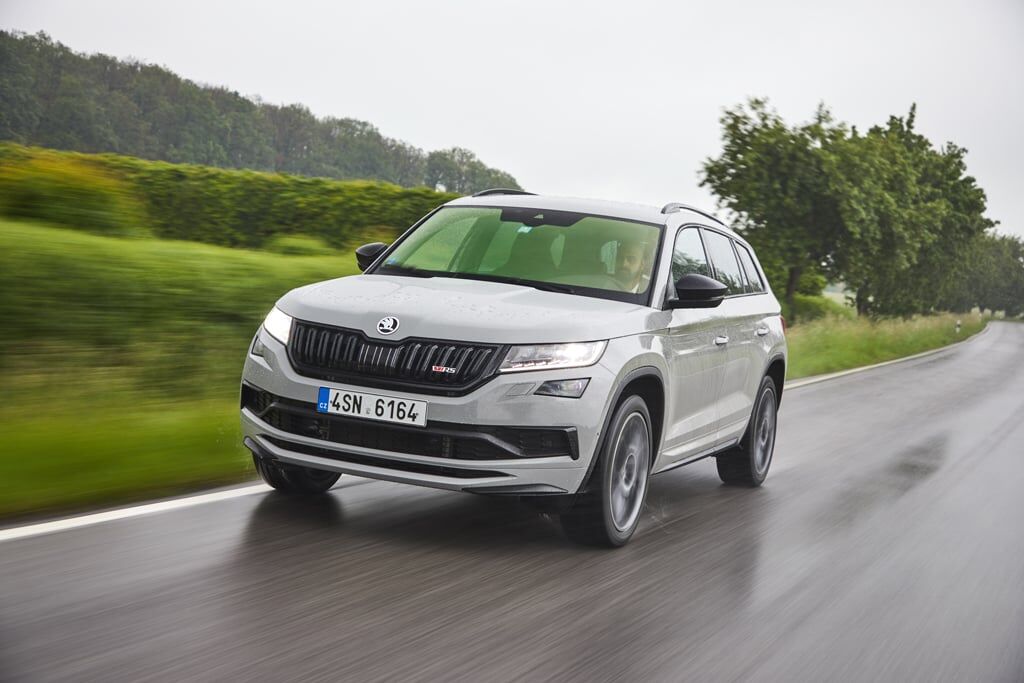Driven: Skoda Kodiaq RS
Driven: Skoda Kodiaq RS
 Driven: Skoda Kodiaq RS
Driven: Skoda Kodiaq RSWhat is it?
Exactly what it says it is! It is a go-faster Kodiaq — Skoda’s flagship 7-seater SUV that has had the wick turned up. The RS (or vRS) badge has always made for exciting Skodas. We’d know, we particularly loved the recently discontinued (in India) Octavia RS. Well, someone at Skoda thought it was a good idea to give the Kodiaq some sporty cred, and here we are. This isn’t a cosmetic job though — the Kodiaq means business. It holds the record for the fastest 7-seater around the Nurburgring Nordschlife at the moment. These Nurburgring records are falling like flies off late, but as of when I wrote this, the Kodiaq RS could still throw its weight (quite literally) around the Green Hell.

Does it look any different?
Yes, both inside and out! While this may not be a cosmetic job, Skoda has done plenty on the surface to keep the Kodiaq RS looking like something deserving of a record at the ‘Ring. Outside, you get glossy black accents to the grille and the rear bumper, both of which have been tweaked to be more aggressive. The wheels are now 20 inchers and have a striking design, the brake calipers are now a bright red. A standard with the Skoda RS cars — the reflector strip above the rear bumper — makes an appearance. On the outside, the Kodiaq retains its familiar face and shape, but the tweaks do make it sharper, and more aggressive. It’s hard to miss the vRS badges on the grille and tailgate.

The insides have been overhauled as well. The layout remains largely the same — you get virtual cockpit as standard, the large, crisp 8-inch screen and seven seats, though in Europe you can spec it with five seats. What’s changed are the materials used. There’s a liberal usage of Alcantara on the seats, the doors and the dash. A few of the plastic bits now have a carbon-fibre-like finish to them. The stitching is now red and there’s vRS badges sprinkled liberally — on the seat’s backrests, the steering wheel, and the gearbox stick. The seats themselves are now firmer and more supportive. The Kodiaq RS remains comfortable, but not over-indulgent like the L&K.
But what’s under the hood?
Now here’s the real party trick. Under the hood is a 2-litre diesel engine with two turbos latched on to it. It makes just under 240bhp and a good 500Nm of torque. This is mated to a DSG twin-clutch gearbox and an all-wheel drive system. I was driving the SUV on narrow Czech village roads and the weather was terribly wet. I could have been at the Green Hell, for all you know.

Get going, and you can immediately tell that this Kodiaq is quick. There’s a surge of torque right from 1800 all the way to 4500rpm, with the redline of 5000rpm. Skoda claims the SUV will do 0-100 in 7 seconds flat — brilliant for such a large car. It’s no Lamborghini Urus, but it is quick. The DSG plays no small part in this, seamlessly shifting up the gears as you get a move on with very momentary breaks in torque.
The Kodiaq RS sounds rather nice as well. There’s a burble at idle and it growls aggressively as the revs climb. Now a lot of that sound is artificial, piped in though the speakers (a first for Skoda), but there’s no denying it adds character to the way the Kodiaq RS drives. It’s not particularly dramatic — no crackles and pops — just a muted growl as you give it the beans. It keeps you entertained. All of this, while having enough boot space for you to move houses.
Like scenic locations and powerful machines? Follow us on Instagram, Facebook, and Twitter
Can it corner?
I mean, it holds a record at the ‘Ring and that counts for something, right? The Kodiaq was already very well behaved around corners, but this one dials it up a notch. The steering is sharp and it turns in really quick — you almost forget you’ve got five full seats behind you. The Kodiaq RS gets a dynamic steering system that alters the weight at speed, giving you more direct control but lightens it up for when you need more steering lock in urban conditions.

The suspension is another highlight. The Kodiaq RS swaps out its passive dampers for dynamic ones. They is taut enough to keep the Kodiaq very composed through quick directional changes, and yet, ride quality isn’t compromised. The roads we were driving on weren’t pothole ridden but they were akin to a bumpy Indian road. The Kodiaq keeps things comfortable in the cabin, not being too stiff and jarring despite being controlled in the corners despite being in the stiffer sport mode.

Are you impressed?
The first time I heard that Skoda had put the RS badge on to the Kodiaq, I was apprehensive. The badge is no joke, and it had to follow in the steps of some legendary Octavias. This was an SUV, and then a diesel. I wasn’t so sure. But then I drove it, and can safely conclude that the Kodiaq RS is deserving of the RS badge.

No, it isn’t coming to India anytime soon — it would be a tad too expensive and won’t make sense. But it is a car that delivers the Thrill of Driving by the bucketload. The regular Kodiaq is one of the better, more refined SUVs in its class and the RS adds dollops of fun to it.
Tech specs
Engine: 1968cc, inline 4-cyl, twin-turbo diesel
Power: 236bhp @ 4000rpm
Torque: 500Nm @ 1750rpm to 2500rpm
Transmission: twin-clutch gearbox, AWD
Weight: 1913kg
0-100kmph: 7 sec (claimed)
Top Speed: 220kmph (claimed)


